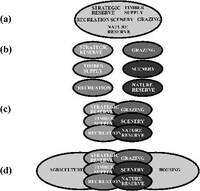Multiple-use forestry
'Multiple use' has multiple meanings.
Most foresters will agree that forestry should be conducted on 'a multiple-use basis'. But the term can be interpreted in several ways. Let us consider six forest uses: a strategic reserve, a timber supply, a recreation resource, grazing land, scenic quality, nature conservation. Since forests are often managed in compartments, these goals could be achieved in four different ways [Fig 8.4].
8.4 'Multiple-use forestry' can be interpreted in several ways: A. Six uses in one compartment; B. Six uses in six separate compartments; C. Six uses in overlapping compartments; D. Six uses overlapping with uses outside the forest
(a) Six uses in one compartment
(b) Six uses in six non-overlapping compartments
(c) Six uses in overlapping compartments
(d) Six uses overlapping with each other with other uses outside the forest.
The most sophisticated alternative, number four, is also the most sustainable - but each of the six forest yields should to be sustained. British forestry has normally been 'one use in one compartment'. Instead, there should be EID for each use.

